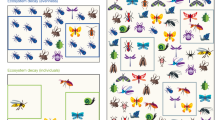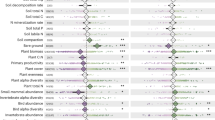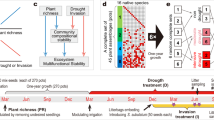Abstract
Considerable recent attention has focused on predicting how the losses of species and functional groups influence ecosystem properties1,2, but the extent to which these effects vary among ecosystems remains poorly understood3,4. Island systems have considerable scope for studying how biotic and abiotic factors influence processes in different ecosystems, because they enable the simultaneous study of large numbers of independent replicate systems at ecologically meaningful spatial scales5,6,7. We studied a group of 30 islands in northern Sweden, for which island size determined disturbance history, and therefore vegetation successional stage and biotic and abiotic ecosystem properties. On each island we conducted a seven-year study that involved experimental removals of combinations of both plant functional groups and plant species. We show that although losses of functional groups and species often impaired key ecosystem processes, these effects were highly context-dependent and strongly influenced by island size. Our study provides evidence that the consequences of biotic loss for ecosystem functioning vary greatly among ecosystems and depend on the specific abiotic and biotic attributes of the system.
This is a preview of subscription content, access via your institution
Access options
Subscribe to this journal
Receive 51 print issues and online access
$199.00 per year
only $3.90 per issue
Buy this article
- Purchase on Springer Link
- Instant access to full article PDF
Prices may be subject to local taxes which are calculated during checkout


Similar content being viewed by others
References
Loreau, M. et al. Biodiversity and ecosystem functioning: current knowledge and future challenges. Science 294, 804–808 (2001)
Hooper, D. U. et al. Effects of biodiversity on ecosystem functioning: a consensus of current knowledge and needs for future research. Ecol. Monogr. 75, 3–35 (2005)
Fridley, J. D. Resource availability dominates and alters the relationship between species diversity and ecosystem productivity in experimental plant communities. Oecologia 132, 271–277 (2002)
Hector, A. et al. Plant diversity and productivity experiments in European grasslands. Science 286, 1123–1126 (1999)
Wardle, D. A. Islands as model systems for understanding how species affect ecosystem properties. J. Biogeogr. 29, 583–592 (2002)
Vitousek, P. M. Oceanic islands as model systems for ecological studies. J. Biogeogr. 29, 573–582 (2002)
Anderson, W. B. & Polis, G. A. Nutrient fluxes from water to land: seabirds affect plant nutrient status on Gulf of California islands. Oecologia 118, 324–332 (1999)
Naeem, S., Thompson, L. J., Lawler, S. P., Lawton, J. H. & Woodfin, R. M. Declining biodiversity can alter the performance of ecosystems. Nature 368, 734–737 (1994)
Tilman, D. et al. Diversity and productivity in a long-term grassland experiment. Science 294, 843–845 (2001)
Hooper, D. U. & Vitousek, P. M. The effects of plant composition and diversity on ecosystem processes. Science 277, 1302–1305 (1997)
Wardle, D. A., Zackrisson, O., Hörnberg, G. & Gallet, C. Influence of island area on ecosystem properties. Science 277, 1296–1299 (1997)
Enquist, B. J. & Niklaus, K. J. Invariant scaling relations across tree-dominated communities. Nature 410, 655–660 (2001)
Hooper, D. U. & Dukes, D. S. Overyielding among plant functional groups in a long-term experiment. Ecol. Lett. 7, 95–105 (2004)
Mulder, C. P. H., Koricheva, J., Huss-Danell, K., Högberg, P. & Joshi, J. Insects affect relationships between plant species richness and ecosystem processes. Ecol. Lett. 2, 237–246 (1999)
Wardle, D. A., Hörnberg, G., Zackrisson, O., Kalela-Brundin, M. & Coomes, D. A. Long term effects of wildfire on ecosystem properties across an island area gradient. Science 300, 972–975 (2003)
Díaz, S., Chapin, F. S. III, Symstad, A., Wardle, D. A. & Huennecke, L. Functional diversity revealed through removal experiments. Trends Ecol. Evol. 18, 140–146 (2003)
Grime, J. P. Benefits of plant diversity to ecosystems: immediate, filter and founder effects. J. Ecol. 86, 902–910 (1998)
Wardle, D. A. Communities and Ecosystems: Linking the Aboveground and Belowground Components (Princeton Univ. Press, Princeton, 2002)
Wardle, D. A., Nilsson, M.-C., Zackrisson, O. & Gallet, C. An ecosystem level perspective of allelopathy. Biol. Rev. 73, 305–319 (1998)
Schmid, B. The species richness–productivity controversy. Trends Ecol. Evol. 17, 113–114 (2002)
Gonzalez, A. & Chaneton, E. J. Heterotroph species extinction, abundance and biomass dynamics in an experimentally fragmented microecosystem. J. Anim. Ecol. 71, 594–602 (2002)
Spiller, D. A. & Schoener, T. W. Folivory on islands with and without insectivorous lizards: an eight-year study. Oikos 78, 15–22 (1997)
Tscharntke, T., Steffan-Deweter, I., Kruess, A. & Thies, C. The contribution of small habitat fragments to the conservation of insect communities of grassland-cropland landscape mosaics. Ecol. Appl. 12, 354–363 (2002)
Coomes, D. A. & Grubb, P. J. Impacts of root competition in forests and woodlands: a theorical framework and review of experiments. Ecol. Monogr. 70, 171–207 (2000)
Technicon Instruments. Individual/Simultaneous Determination of Nitrogen and/or Phosphorus in BD Acid Digests (Technicon Industrial Systems, Tarrytown, 1997)
Anderson, J. P. E. & Domsch, K. H. A physiological method for the quantitative measurement of microbial biomass in soils. Soil Biol. Biochem. 10, 215–221 (1978)
Wardle, D. A. Changes in the microbial biomass and metabolic quotient during leaf litter succession in some New Zealand forest and scrubland ecosystems. Funct. Ecol. 7, 346–355 (1993)
Acknowledgements
We thank A. Sundberg, P. Bellingham, K. Svarvisdottir, C. Maley, N. Anthes, K. Altgott, N. Rodda and K. Orwin for field assistance at various stages of this work; H. Quirk, M. Karlsson and K. Orwin for laboratory assistance; K. Johansson for help with data management; D. Peltzer for assistance with statistics; and T. H. De Luca, T. Fukami, M.-C. Nilsson and D. Peltzer for comments on earlier versions of this manuscript. This work was funded by the Swedish Natural Sciences Research Council (NFR) and Vetenskapsrådet (VR).
Author information
Authors and Affiliations
Corresponding author
Ethics declarations
Competing interests
Reprints and permissions information is available at npg.nature.com/reprintsandpermissions. The authors declare no competing financial interests.
Supplementary information
Supplementary Discussion
This explores the issue of the extent to which the vegetation data obtained at the end of the experiment (after seven years) is explicable simply in terms of legacy effects created by the experimental removals at the beginning of the experiment. (DOC 21 kb)
Supplementary Table 1
This complements the Supplementary Discussion by providing data on productivity and amounts of vegetation removed from plots for dwarf shrub vegetation on islands of three size classes. (DOC 23 kb)
Rights and permissions
About this article
Cite this article
Wardle, D., Zackrisson, O. Effects of species and functional group loss on island ecosystem properties. Nature 435, 806–810 (2005). https://doi.org/10.1038/nature03611
Received:
Accepted:
Issue Date:
DOI: https://doi.org/10.1038/nature03611
This article is cited by
-
The current state of forest ecosystems in the Khosta Yew-Boxwood Grove
Environmental Monitoring and Assessment (2023)
-
The Effects of Shrub Removal on Soil Microbial Communities in Primary Forest, Secondary Forest and Plantation Forest on Changbai Mountain
Microbial Ecology (2023)
-
Plant–rodent interactions after a heavy snowfall decrease plant regeneration and soil carbon emission in an old-growth forest
Forest Ecosystems (2021)
-
Mangrove fragments as key coastal reservoirs of taxonomic and functional biodiversity
Biodiversity and Conservation (2021)
-
Biodiversity and nature conservation in island ecosystems: spatiotemporal changes in Socotra archipelago (Yemen)
Journal of Coastal Conservation (2020)
Comments
By submitting a comment you agree to abide by our Terms and Community Guidelines. If you find something abusive or that does not comply with our terms or guidelines please flag it as inappropriate.



